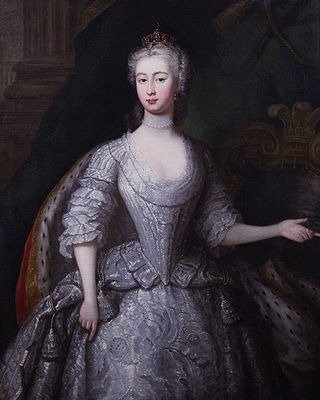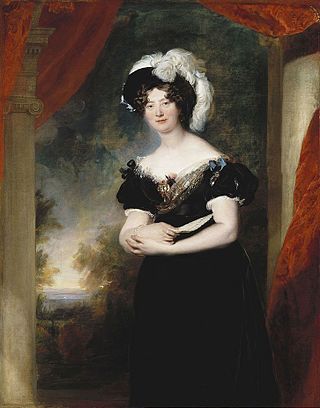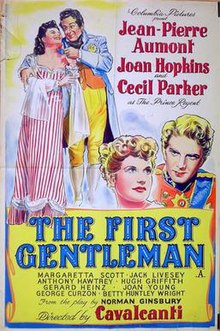
Caroline of Brunswick-Wolfenbüttel was Queen of the United Kingdom of Great Britain and Ireland and Queen of Hanover from 29 January 1820 until her death in 1821 as the estranged wife of King George IV. She was Princess of Wales from 1795 to 1820.

Caroline of Brandenburg-Ansbach was Queen of Great Britain and Ireland and Electress of Hanover from 11 June 1727 until her death in 1737 as the wife of King George II.

Leopold I was the first king of the Belgians, reigning from 21 July 1831 until his death in 1865.

Princess Augusta of Saxe-Gotha-Altenburg was Princess of Wales by marriage to Frederick, Prince of Wales, eldest son and heir apparent of King George II. She never became queen consort, as Frederick predeceased his father in 1751. Augusta's eldest son succeeded her father-in-law as George III in 1760. After her spouse died, Augusta was the presumptive regent of Great Britain in the event of a regency, until her son reached majority in 1756.

Princess Charlotte Augusta of Wales was the only child of George, Prince of Wales, and his wife, Caroline of Brunswick. She was expected to ascend the British throne after the deaths of her grandfather, George III, and her father, but died in childbirth at the age of 21, predeceasing them both.

Charlotte, Princess Royal, was Queen of Württemberg as the wife of King Frederick I. She was the eldest daughter and fourth child of George III of the United Kingdom and his wife, Charlotte of Mecklenburg-Strelitz.

Christian Friedrich Freiherr von Stockmar was a German physician and statesman, who was a leading player in the affairs of the United Kingdom under Queen Victoria.

Princess Mary, Duchess of Gloucester and Edinburgh was the eleventh child and fourth daughter of King George III and his consort Charlotte of Mecklenburg-Strelitz.

Mariana Victoria of Spain was an Infanta of Spain by birth and was later the Queen of Portugal as wife of King Joseph I. She acted as regent of Portugal in 1776–1777, during the last months of her husband's life and as advisor to her daughter, Maria I of Portugal, in her reign.

Frederick, Hereditary Prince of Denmark was heir presumptive to the thrones of Denmark and Norway. He was the only surviving son of King Frederick V by his second wife, Juliana Maria of Braunschweig-Wolfenbüttel.

Princess Augusta Sophia was the sixth child and second daughter of King George III and Queen Charlotte.

Frances Villiers, Countess of Jersey was a British courtier and Lady of the Bedchamber, one of the more notorious of the many mistresses of King George IV when he was Prince of Wales, "a scintillating society woman, a heady mix of charm, beauty, and sarcasm".

Louise of Orléans was the first Queen consort of the Belgians as the second wife of King Leopold I from their marriage on 9 August 1832 until her death in 1850. She was the second child and eldest daughter of the French king Louis Philippe I and his wife, Maria Amalia of the Two Sicilies. Louise rarely participated in public representation, but acted as the political adviser of her spouse. Her large correspondence is a valuable historical source of the period and has been published.

A Royal Scandal is a 1996 British television docudrama produced and directed by Sheree Folkson. The teleplay by Stanley Price focuses on the ill-fated marriage of George IV and Duchess Caroline of Brunswick. Dialogue from actual historical records reveals how each party tries to humiliate the other, causing the monarchy to suffer great embarrassment. Narrated by Ian Richardson, the drama was broadcast by the BBC.

Élisabeth Charlotte d'Orléans was a petite-fille de France and duchess of Lorraine and Bar by her marriage to Duke Leopold. She was regent of the duchy during the minority (1729–1730) and absence (1730–1737) of her son and suo jure princess of Commercy 1737–1744. Among her children was Francis I, Holy Roman Emperor, the co-founder of the House of Habsburg-Lorraine.

Louise Diane d'Orléans was Princess of Conti from her marriage to Prince Louis François in 1732, until her death in childbirth. She was the youngest child of Philippe II, Duke of Orléans and Françoise Marie de Bourbon, the youngest legitimised daughter of King Louis XIV of France and his mistress Madame de Montespan. She was born while her father was the regent for Louis XV. Some sources referred to her as Louis Diane.

Henrietta Mariana "Marianne" Charlotta Koskull was a Swedish noble and lady-in-waiting, known as the royal mistress of King Charles XIII of Sweden and King Charles XIV John of Sweden.

Anne Charlotte of Lorraine was the Abbess of Remiremont and Mons. She was the thirteenth of fifteen children of Leopold, Duke of Lorraine, and his spouse Élisabeth Charlotte d'Orléans. Her mother was the niece of Louis XIV of France and sister of Philippe II, Duke of Orléans and Regent of France during the minority of Louis XV.

Prince Regent is a British period television series made and transmitted by the BBC in 1979. It depicts the life of George IV from his youth time as prince regent and his reign as King. It consists of eight episodes of 50 minutes.
Catherine Osborne, Duchess of Leeds, formerly Catherine Anguish, was a British courtier. She was the second wife of Francis Osborne, 5th Duke of Leeds.



















